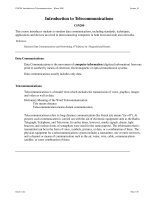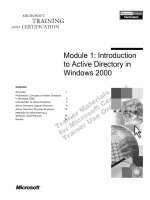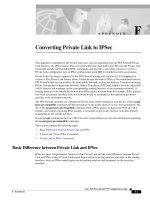Tài liệu Converting Private Link to IPSec ppt
Bạn đang xem bản rút gọn của tài liệu. Xem và tải ngay bản đầy đủ của tài liệu tại đây (117.93 KB, 8 trang )
F-1
Cisco PIX Firewall and VPN Configuration Guide
78-13943-01
APPENDIX
F
Converting Private Link to IPSec
This appendix is intended for the Private Link users who are migrating from the PIX Firewall Private
Link feature to the IPSec feature. This section describes the main differences between the Private Link
commands and the corresponding IPSec commands, and provides a procedure for how to convert a
Private Link configuration into an IPSec configuration using IKE to establish security associations.
Private Link is no longer supported in the PIX Firewall starting with version 5.0. It is supported in
version 4. The Private Link feature allows Virtual Private Networks (VPNs) to be established between
PIX Firewalls that are connected to the same public network, such as the Internet. It enables incoming
Private Link packets to bypass the Network Address Translation (NAT) and Adaptive Security Algorithm
(ASA) features and terminate on the corresponding sending interface of the destination network. A
sending interface is the interface from which the IPSec packet was sent from. For example, IPSec packets
sent from a perimeter interface from one network would be terminated at the equivalent perimeter
interface at the destination network.
The PIX Firewall currently can simulate the Private Link inside termination with the use of the sysopt
ipsec pl-compatible command, but the termination on the inside interface is not a true termination. The
use of the sysopt ipsec pl-compatible command allows IPSec packets to bypass the NAT and ASA
features, and enables incoming IPSec packets to terminate on the inside interface only after initially
terminating on the outside interface.
See the sysopt command in the Cisco PIX Firewall Command Reference for more information regarding
the sysopt ipsec pl-compatible command.
This section contains the following topics:
•
Basic Difference between Private Link and IPSec
•
Private Link Versus IPSec Commands
•
Private Link to IPSec Conversion
Basic Difference between Private Link and IPSec
IPSec is a more comprehensive feature set than Private Link and the main difference between Private
Link and IPSec is that a Private Link tunnel begins on the receiving interface and ends on the sending
interface, while an IPSec tunnel begins on the sending interface and terminates on the receiving
interface.
F-2
Cisco PIX Firewall and VPN Configuration Guide
78-13943-01
Appendix F Converting Private Link to IPSec
Private Link Versus IPSec Commands
This section contains the following topics:
•
Link
•
Linkpath
•
Age
Table F-1 outlines the mapping of the core Private Link commands with the corresponding IPSec
commands. A description of each command follows.
For more information about the IPSec-related commands listed in Table F-1, refer to the following
command pages in the Cisco PIX Firewall Command Reference:
•
access-list
•
crypto ipsec
•
crypto map
•
isakmp
•
sysopt
Table F-1 Mapping of Private Link Commands with IPSec Commands
Private Link Commands IPSec Commands
None sysopt ipsec pl-compatible
link (inside) remote_peer_ip key_id key
1.
isakmp policy priority authentication
pre-share
2.
isakmp key keystring address peer-address
3.
crypto map map-name interface
interface-name
link remote_peer_ip md5
1.
crypto ipsec transform-set
transform-set-name esp-des ah-md5-hmac
2.
crypto map map-name seq-num set
transform-set transform-set-name
linkpath remote_network_ip remote_netmask
remote_peer_ip
1.
access-list access-list-name permit ip any
remote_network_ip remote_netmask
2.
crypto map map-name seq-nummatch address
access-list-name
3.
crypto map map-name seq-num set peer
ip-address
age minutes crypto ipsec security-association lifetime seconds
seconds
F-3
Cisco PIX Firewall and VPN Configuration Guide
78-13943-01
Appendix F Converting Private Link to IPSec
Link
The link command creates an encrypted path between Private Link-equipped PIX Firewall units. This
command also enables Private Link to associate the shared private keys between the local host and a
remote peer. The isakmp key command in IPSec enables the local host to associate a shared key with a
remote peer.
Note
Private Link uses up to seven shared keys between two hosts and rotates among the seven keys. ISAKMP
uses only one shared key between any two hosts to authenticate and dynamically negotiate other keys to
protect the communication as necessary.
The link command allows for the configuration of per packet authentication protection. In IPSec, the
analogous protection is provided by the transform-set combination of ah-md5-hmac or esp-md5-hmac.
You configure a transform set using the crypto ipsec transform-set command. See the set
transform-set command in the Cisco PIX Firewall Command Reference for more information regarding
this command.
Example F-1 defines two transform sets and specifies that they can both be used within a crypto map
entry. This example applies only when IKE is used to establish security associations. With crypto maps
used for manually established security associations, only one transform set can be included in a given
crypto map entry.
Example F-1 Configuring Transform Sets
crypto ipsec transform-set my_t_set1 ah-md5-hmac
crypto ipsec transform-set my_t_set2 ah-md5-hmac esp-md5-hmac
crypto map mymap 10 ipsec-isakmp
match address 101
set transform-set my_t_set1 my_t_set2
set peer 10.0.0.1
set peer 10.0.0.2
In this example, when traffic matches access list 101, the security association can use either transform
set my_t_set1 (first priority) or my_t_set2 (second priority) depending on the transform set that matches
the transform set on the remote peer.
Linkpath
The linkpath command identifies the internal and external network interfaces on the remote peer
running Private Link. The linkpath address selectors are used to select inbound traffic at the local,
internal interface to encrypt and tunnel to the remote peer. In the reverse direction, the linkpath address
selectors are used to decrypt outbound traffic, which originated from the remote peer, at the internal
interface.
The PIX Firewall can have two or more network interfaces. For any pair of interfaces, one of the
interfaces is the local, or internal interface, and one is the outside interface. The relative security level
of the interface defines whether it is the local or outside interface; that is, the interface with the higher
security level is the local interface, while the interface with the lower security level is the outside
interface. For example, a perimeter interface with a security level of 70 is the local interface relative to
another perimeter interface with a security level of 40.
F-4
Cisco PIX Firewall and VPN Configuration Guide
78-13943-01
Appendix F Converting Private Link to IPSec
The linkpath command identifies the internal and external network interfaces on the remote peer
running Private Link. The linkpath command address selectors are used to select inbound traffic at the
inside interface to encrypt and tunnel to the remote peer. In the reverse direction, the linkpath command
address selectors are used to decrypt outbound traffic, which originated from the remote peer, at the
inside interface.
In IPSec, the access-list command statement address selectors in the crypto map are used to select
outbound traffic from the internal interface to encrypt and tunnel to the remote peer. In the reverse
direction, the access-list command statement address selectors are used to decrypt inbound traffic, which
originated from the remote peer, at the outside interface.
Use the following steps to convert from a linkpath tunnel into an IPSec tunnel. These steps are included
within “Private Link to IPSec Conversion:”
Step 1
Define an access-list command statement that has the same address selectors as your linkpath command
statement. (Step 6 in "Private Link to IPSec Conversion.")
Step 2
Associate the defined access-list command statement with a crypto map entry. (Step 7 in "Private Link
to IPSec Conversion.")
Step 3
Associate the linkpath remote peer as the crypto map peer. (Step 10 in "Private Link to IPSec
Conversion.")
Age
Private Link selects the next shared key in a “round-robin” method. The age command is used to define
the number of minutes a current shared key is used before the rotation.
In IPSec, the crypto ipsec security-association lifetime seconds command is used to define the
duration the current shared key and the security association are used before their set time expires.
Private Link to IPSec Conversion
This section provides the steps to convert your Private Link configuration into an IPSec configuration.
An example of a Private Link configuration between two PIX Firewall units is provided for reference.
Figure F-1 shows the Private Link network diagram example to which to refer in this section.
F-5
Cisco PIX Firewall and VPN Configuration Guide
78-13943-01
Appendix F Converting Private Link to IPSec
Figure F-1 Example Private Link Network Diagram
The Private Link network diagram shown in Figure F-1 corresponds to the following configurations.
On PIX Firewall A, the Private Link configuration is as follows:
link 192.168.37.1 1 fadebacfadebac
link 192.168.37.1 2 bacfadefadebac
link 192.168.37.1 3 baabaaafadebac
link 192.168.37.1 4 beebeeefadebac
linkpath 10.3.0.0 255.255.255.0 192.168.37.1
10.1.1.1
(Inside)
192.168.35.1
(Outside)
192.168.35.2
PIX
Firewall A
PIX
Firewall B
10.1.0.0
Network A
Global
IP Address:
192.168.35.8-
192.168.35.23
10.3.1.1
(Inside)
192.168.37.1
(Outside)
192.168.37.2
29612
Global IP
Address:
192.168.37.8-
192.168.37.23
10.3.0.0
Network B
Internet
Router A Router B









